I arrived at Narita airport and rechecked my luggage. I ate lunch and walked around the airport a bit. I had been to this airport before when I was on the Fulbright Memorial Program in Tokyo and it is a very simple place to navigate through.
My flight to Naha was very nice and there were very few people on this flight. I actually got to sit in the front and the leg room in the seats was incredible (you could stretch your legs straight out without touching the seat in front of you. I slept the entire flight there and felt much better.
When I received my luggage, I was warmly greeted by Gibu Sensei, Makato Gibu, Hisashi Izumi and Sumi Sunigawa. They are always so kind to come to the airport when we come to Okinawa and it is always a great feeling of homecoming to see them. We went to a kissaten (coffee shop) in the airport to chat and catch up before everyone had to go home. They told me that a large typhoon was going to directly hit the island on Friday and that I was lucky to get there before it came.
Izumi San drove me to his home in Okinawa City where his wife Hiroko, son Toshinari and daughter Aiko were waiting. Today was Hiroko san's birthday and we ate dinner and had a birthday cake for her. We had some Orion beer and stayed up late catching up each other's lives.
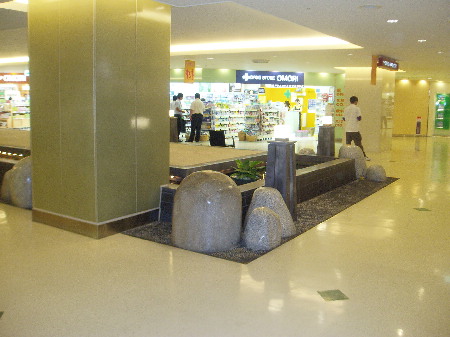 |
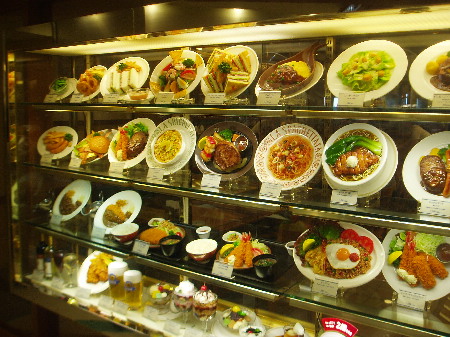 |
|
|
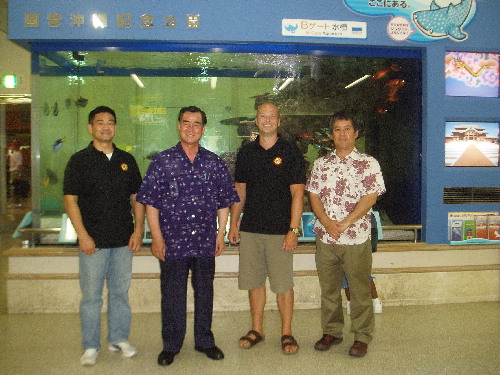 |
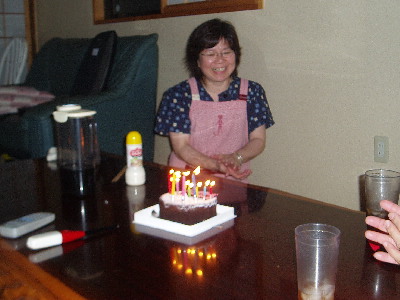 |
|
|
|
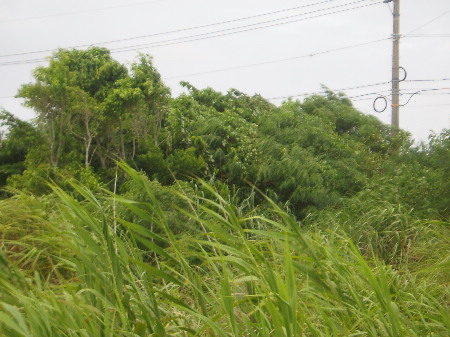 |
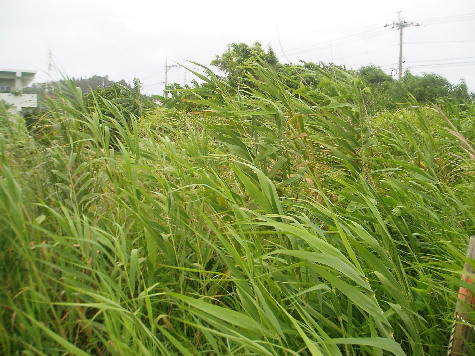 |
|
Thursday July 12
I slept only three hours and woke up around 3:30 a.m. I wrote in my journal and worked on the website a bit to pass the time away. Izumi San and I left to do the morning safety crossing guard duty at 7:30 as the children in the Chou area left for school. It is funny to see the same tired faces of children that exist all over the world when they have to go to school. However, in Okinawa, true to their culture and hearts, the children still answer back "Ohaiyo gozaimasu" with a smile when you greet them at the street corner.
|
|
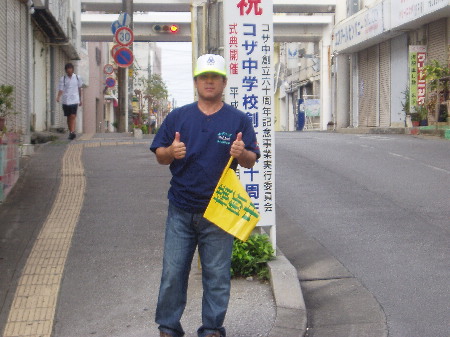 |
|
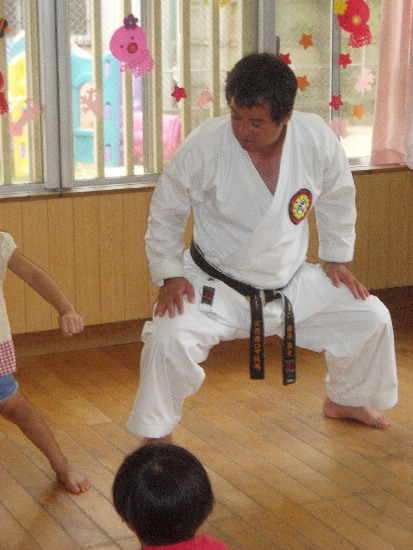 |
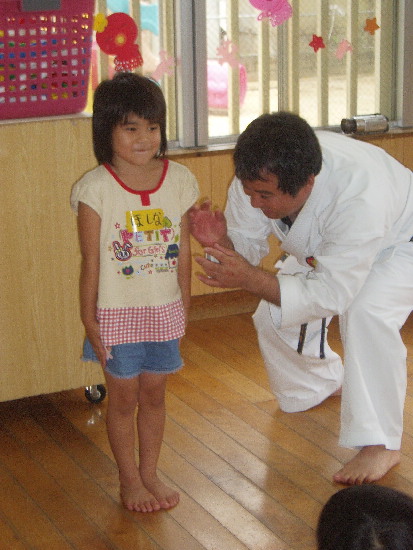 |
|
We came back and talked awhile before leaving to teach karate at a local kindergarten in Okinawa City. Izumi San teaches at many schools and Montessori schools in the Chatan and Okinawa City area before arriving at his photo studio next to his wife's hair salon. He is a very energetic teacher who motivates all of his students but also stresses the importance of understanding Okinawa dento bunka (traditions and culture) history and uchina guchi (Okinawa language).
The children at the school were very energetic and followed the instructions well. After demonstrating kata, I popped them popcorn with an air popper that I gave Izumi san for Christmas. They were very cute and were fascinated when the kernels began to "jump." After their karate class, we ate lunch together and Izumi san and I got to sit with different groups of children. Their lunch was very tasty and consisted of spaghetti, potato salad, mushroom soup and an orange slice. It was fun sitting with the children and they were very eager to ask questions to the strange, Japanese-speaking gaiijin.
|
|
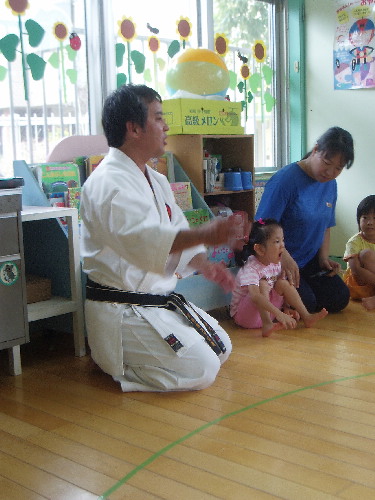 |
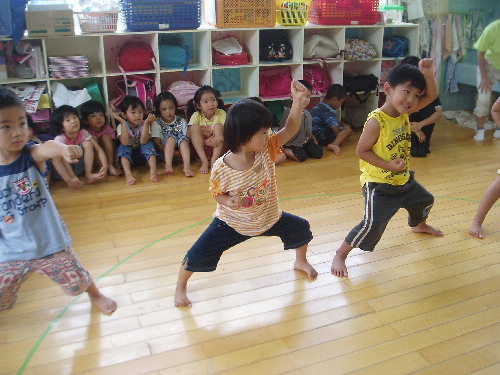 |
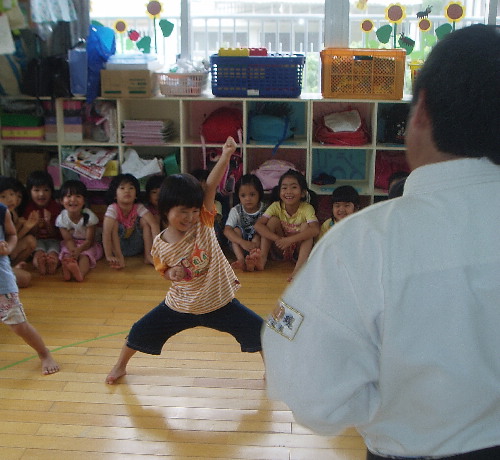 |
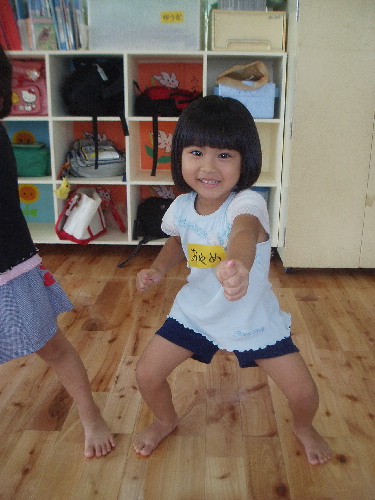 |
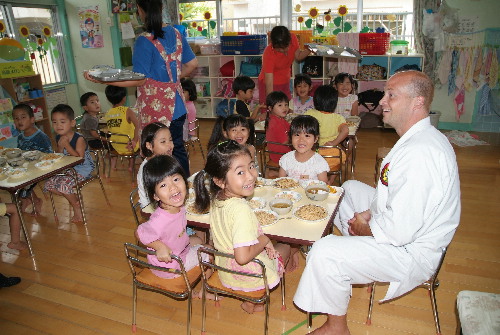 |
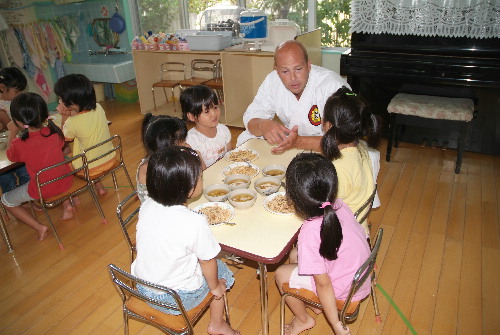 |
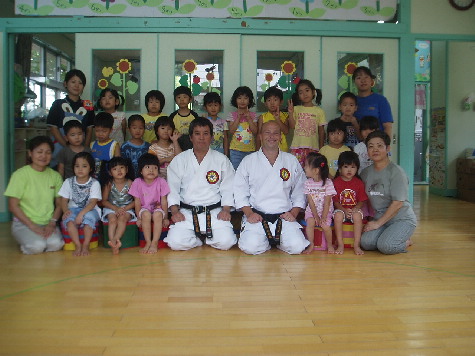 |
 |
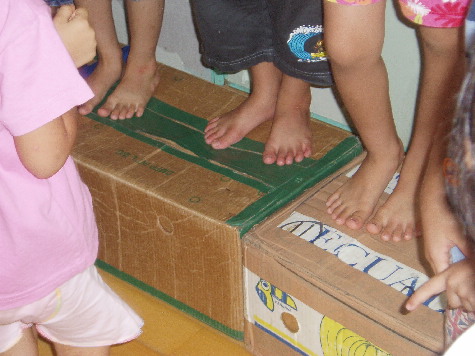 |
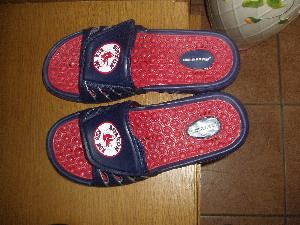 |
|
After pictures, we left to go back home and then it was off to the photo studio so Izumi san could check in. We went shopping around Gushikawa and Uruma looking for things for Lorie, Madison and Emily as well as some things that Hiroko san had asked us to find.
I suggested to Izumi San that we go Awase for lunch at the market near the docks so we could eat something before I left for the Hombu dojo. Awase has fresh seafood everyday and the market is exciting to walk around. We had an incredible lunch and were very glad that we made the stop.
|
|
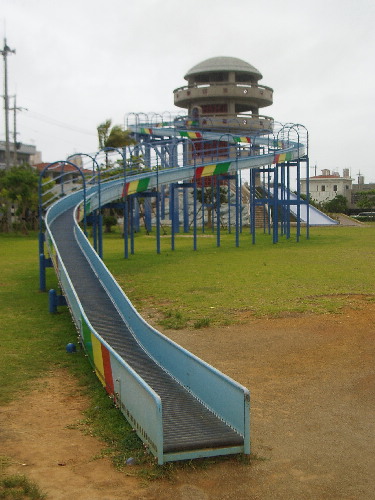 |
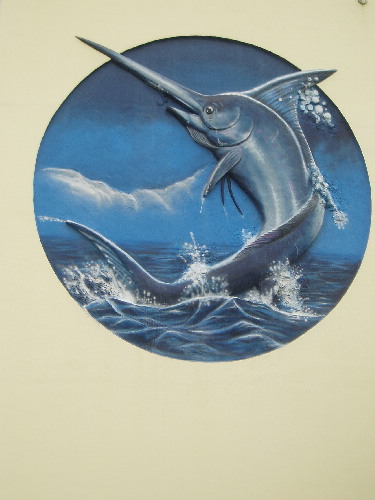 |
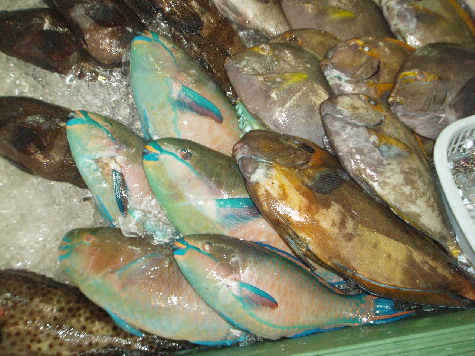 |
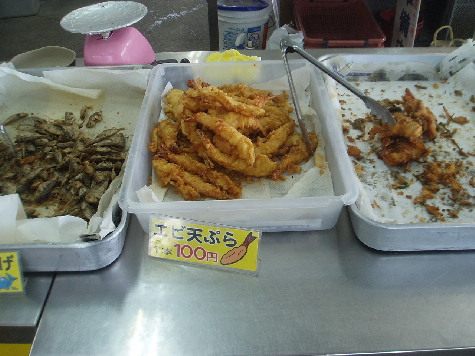 |
|
|
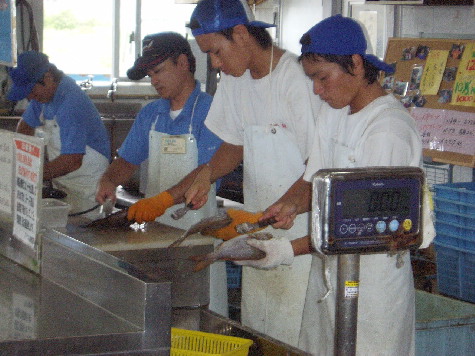 |
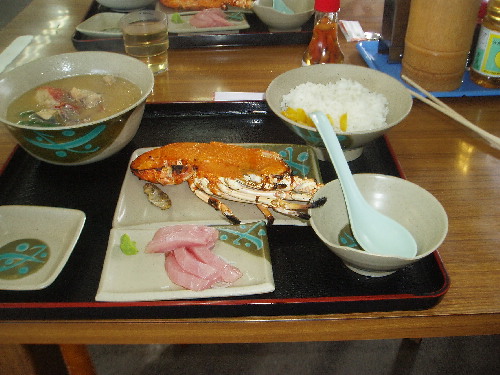 |
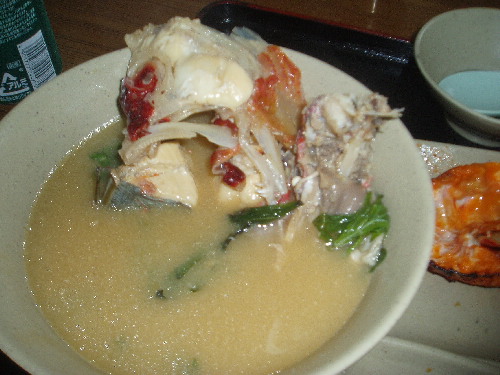 |
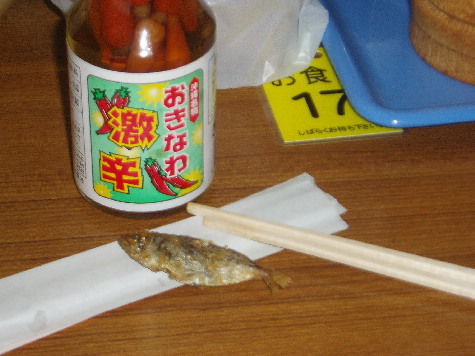 |
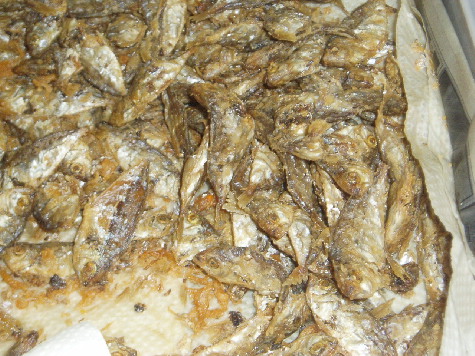 |
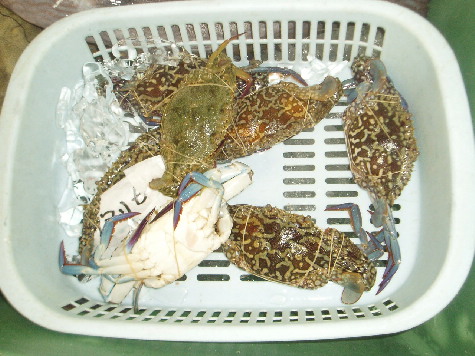 |
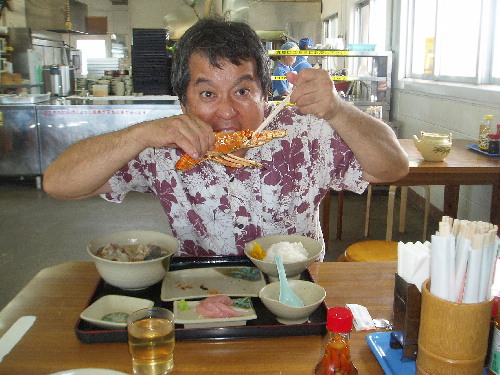 |
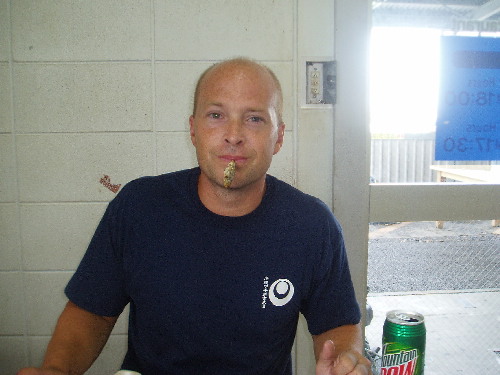 |
|
After returning, we had time to relax as the weather starting getting dark and stormy with the incoming typhoon. Izumi san drove me to the Hombu dojo so that I could get private training with Gibu Sensei before the main classes started.
Sensei arrived home from work and greeted me with his ever-present smile. It is so neat that he is so kind and gentle but at the same one of the most powerful karateka of his generation. He presented me with a beautiful Karayushi shirt and I presented gifts from the dojo.
We got right to training as he checked all of the kata in the syllabus. The first training night upon arriving to Okinawa is the worst experience for your body. On top of jet lag, your body is dying from the humidity of July and the dojo is like an oven. All of the training that you do leading up to any trip to Okinawa doesn't prepare you for the adjustment of the first week of training. The marines at the local bases are not allowed to work out with their squads for 6 weeks once they arrive in Okinawa and actually wear yellow t-shirts to indicate their probationary status for PT. Everyone's body has to adjust to the humidity and high temperatures here otherwise they are at risk to heat stroke.
|
|
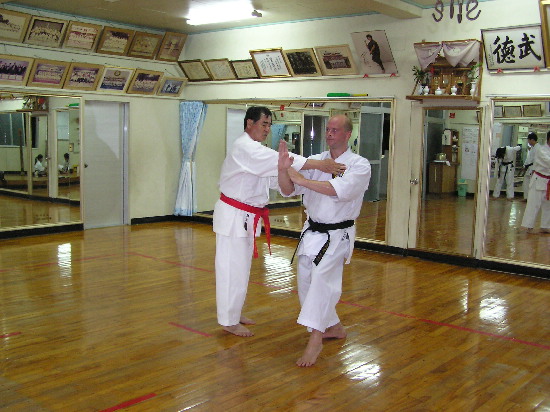 |
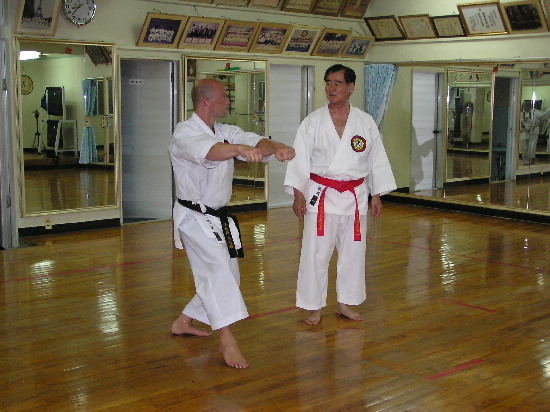 |
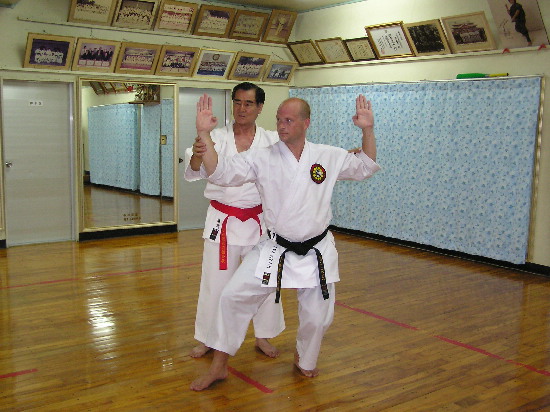 |
|
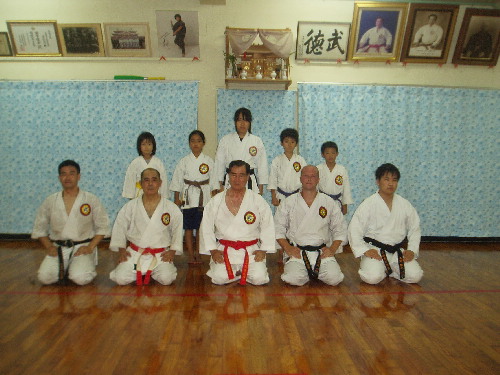 |
 |
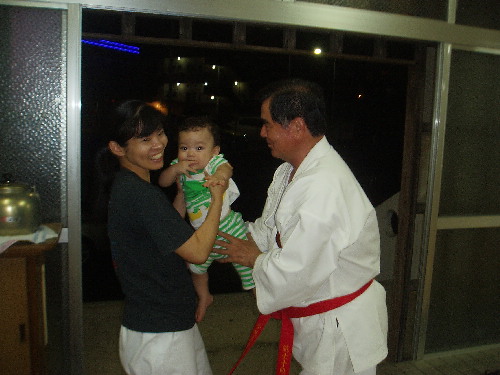 |
The incoming typhoon kept many students home on this evening as there was only Yagi San/7th dan, Makato San/6th dan and two children for the first class. After wards, two teenage black belts joined us as well as Izumi san/6th dan, Daigo san/4thdan, his wife Mamoko san/4th dan, and Tamaki San/8th dan.
Gibu Sensei gave us a long question and answer session about kata, kobudo and applications. He is very quick to point out that there are too many people that think that all of the moves in the kata have applications. He said that many of the bunkai were carried over from China or applied to certain situations long ago but had more historical meaning than actual application. He said that it is okay to analyze what movements could be however it is wrong to think that there are hidden meanings to every move. Some are just kamae or movements so that the kata can be completed in a pattern or sequence. This is the same explanation that I have heard from other Senior Okinawa sensei. He used the turn on Pinan Sandan as an example.(When you turn around and bring both hands up to your side to begin the final sequence with the empi uke and uraken) I have heard this explained as a throw, as a break, etc. When I asked him about this, he looked at me like I had two heads and said "Kamae only."
It was a very rewarding practice as all are with Sensei and so Izumi san and I returned to Okinawa City with many things to talk about that we learned that evening. We changed quickly and went my favorite restaurant in Koza. The Lemon Grass is television's "Cheers" in Okinawa City and you have to be a local in order to find it. It is tucked away on a side street where all great places are. I was happy to see the owners again and Izumi san and I were not disappointed in the house specialty of tebichi (pigs feet) and goya champaru.
We came home and went to sleep with loud sounds of the immense typhoon hitting the island.
|
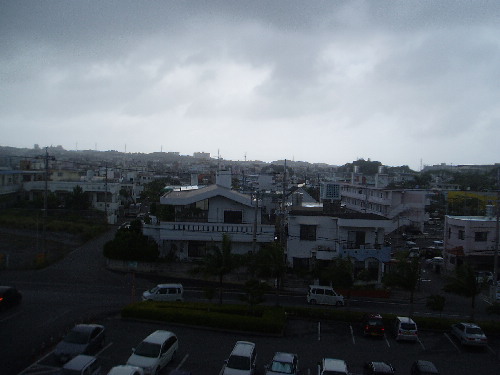 |
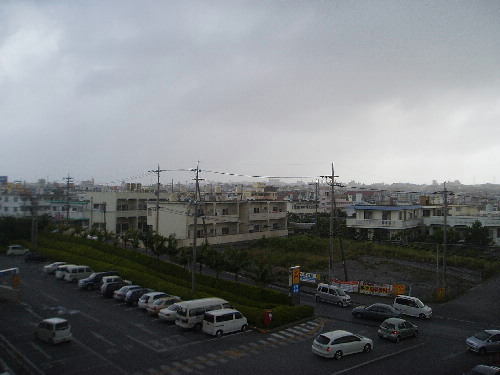 |
|
|
|
|
|
|
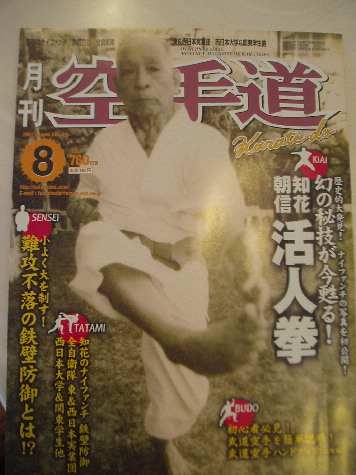 |
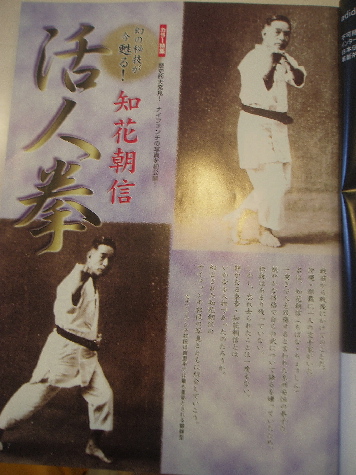 |
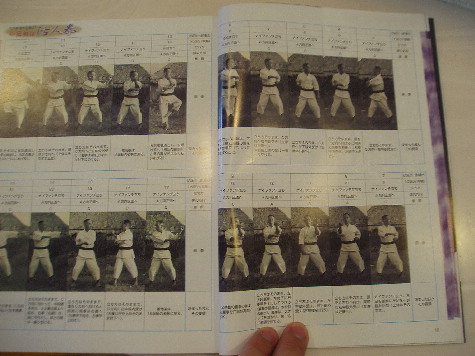 |
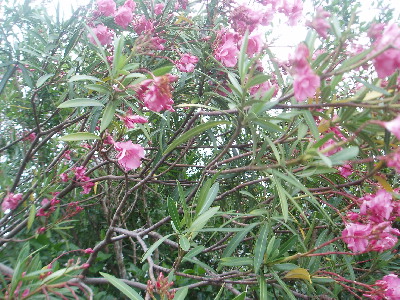 |
|
Friday July 13
I woke up around 5:30 to the loudest wind I have ever heard with the typhoon pounding Okinawa. The sound of the wind whipping between the concrete homes and buildings sounded like some unseen wild animal in a rage. Everyone slept in since there was no school and businesses were closed due to the weather. The whole family took advantage of this rest time that they usually never receive with their busy schedules. I went back to bed and worked on downloading pictures from the previous day and reviewing Gibu Sensei's kata corrections and mechanics from the day before.
|
|
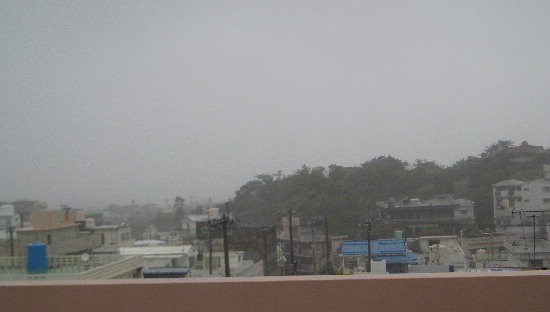 |
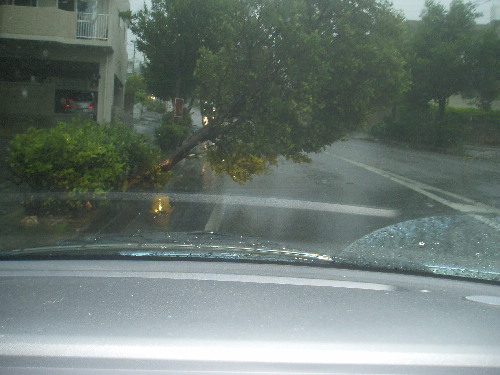 |
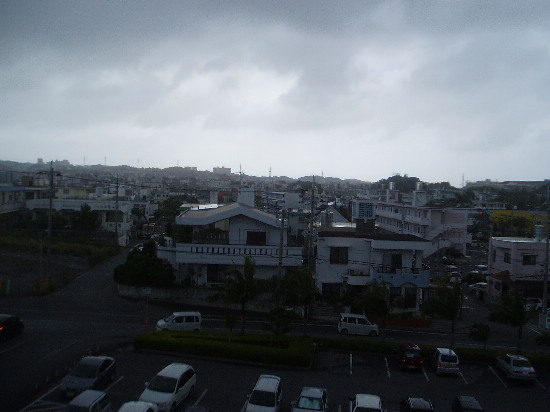 |

Quicktime Movie of Izumi Sensei and I driving during the storm
Nothing like a little ACDC as a soundtrack to a typhoon!
|
|
Hiroko san was kind enough to rent her favorite Samurai movie "Twilight Samurai" which stars the Japanese Actor Hiroyuki Sanada who played the strong warrior in "The Last Samurai." Hiroko san made a great lunch and we all watched the movie during the afternoon.
Later, Izumi san and I sat upstairs listening to storm and talked about karate and family for about 2 hours. This is one of my favorite times when I have the opportunity to talk with him one on one and exchange ideas about karate and teaching.
We eventually set out in the typhoon looking for a grocery store that was open since Hiroko San needed some supplies. There was nothing open except a Lawson store and a Family Mart so we bought what we could and headed home with ACDC cranked up on the radio. It is pretty funny to be listening to "Highway to Hell" when you are driving around in a huge typhoon. We stopped by Sensei Fusei Kise's dojo Kenshinkan since we saw the lights were on and took a picture of the sign.
After returning home, we ate dinner and then headed to bed early since we had a lot of cleaning up to do in the morning and Izumi San and Hiroko San had appointments at their businesses.
|
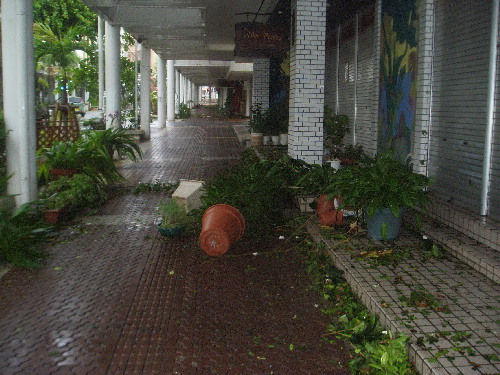
|
|
|
|
Saturday July 14, 2007
I woke up around 5:30 and went up to Izumi San's okujo (roof top) to take a look at things and experience the lingering winds of the typhoons. Although the rain had let up a bit, the wind was still beating the island and it was a neat sight to see the clouds racing north towards Ishikawa.
Izumi san and I left for his studio to clean up the leaves, mud and trash that had blown up the stairs around the studio and around the store front. I raked and swept the area and then hosed everything down so that customers could come up. Everyone around BC street was busy doing the same and making the walkways clean again. In true Yuimaruu fashion, everyone was helping each other so that all of the businesses could open on time and that the areas looked good for all.
I returned and spent the rest of the morning in the dojo training on the makiwara, shin bag, and reviewing kata. Izumi San had two members of his kata team come to the dojo and asked me to coach them on their kata for tomorrow's tournament at the Budokan, which our students competed in last year. Izumi san is a great teacher and his students didn't need any help but I was honored by his request. He coached his two kumite students for their full contact tournament in the morning as well.
|

 Quicktime video of Izumi Sensei working on iri kumi with two students Quicktime video of Izumi Sensei working on iri kumi with two students
Video 1
Video 2
|
|
Sunday July 15
I woke up at 6:00 to get ready for the tournament in Naha. One of the student's grandmother picked me up and drove Yuta and I to the Budokan. It was already packed and we had to catch a shuttle bus next to the Seaman's Club. Once there, I met up with Gibu Sensei and briefly talked before picking up my coach information and badge. There were many students this year competing at the tournament with teams from all over Okinawa and mainland Japan.
It was very interesting to see all of the new associations that have developed on Okinawa. In the 50's and 60's, there were also different associations but there are many new ones coming out of the major ryuha. It is also interesting to see how the Kaicho of each style has changed the original kata movements to distinguish his association from others. Gibu Sensei told me that to do this for tournaments only is maybe okay but to change the original kata for one's style waters down history. Kata varies from one person to another based on body type but everyone should make efforts not to change things that are so important in Okinawa karate and kobudo history.
After the first and second year elementary school students competed, it was time for Izumi Sensei 's group. The kids did very well and finished in the middle of the scorings. Sunagawa San and I took advantage of our break and walked to a restaurant near the monorail. She said that it was opened 24 hours and was very good food for the price. We met back with Izumi san at the Budokan to watch some of the junior high school students compete. They were all extraordinary athletes however all of the kata resemble mechanics from Japanese Kata.
I was told that in junior high competition, very rarely is traditional Okinawan kata used. Many of the students all fall back on Japanese kata because it is more flashy and execution of the techniques are more centered around speed. It is sad that so much history is overlooked for a trend of martial arts that emphasizes looks rather than content. It is more saddening that the next generation of Okinawan karateka are being pushed into thinking that their homeland's kata is not worthy of study. It is not to say that the Japanese kata or styles for that matter are bad, they are extremely worthy of praise and admiration.
I meet Tomoshiro Sensei who is the Okinawan Women's Kata Champion and owns her own Ryuei Ryu dojo. She was very nice and had a line of children in front of her trying to get her autograph and a picture with this karate star.It was very cute to see the children flock around her as if she were a movie star.
|
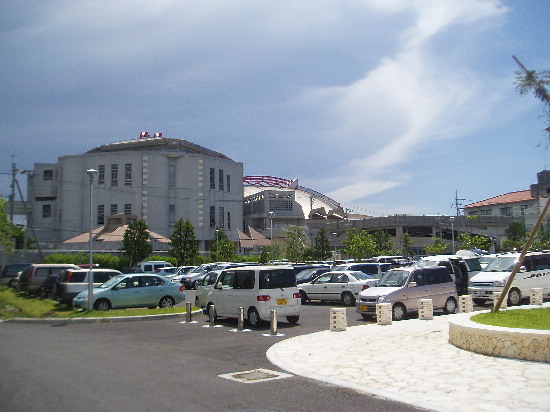 |
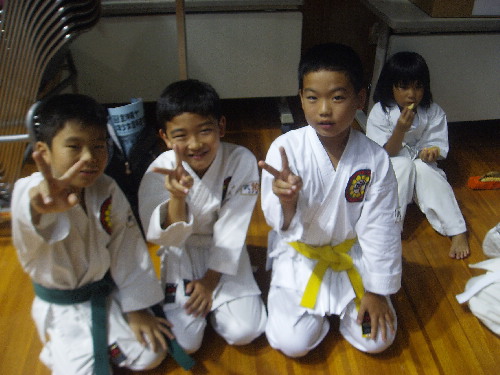 |
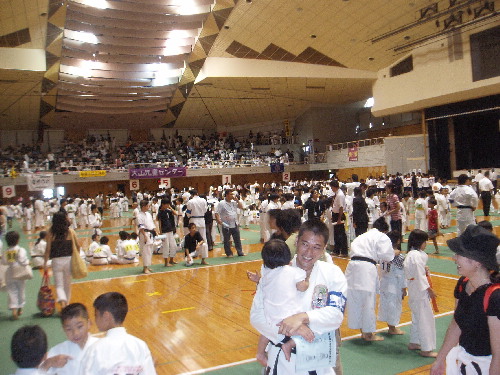 |
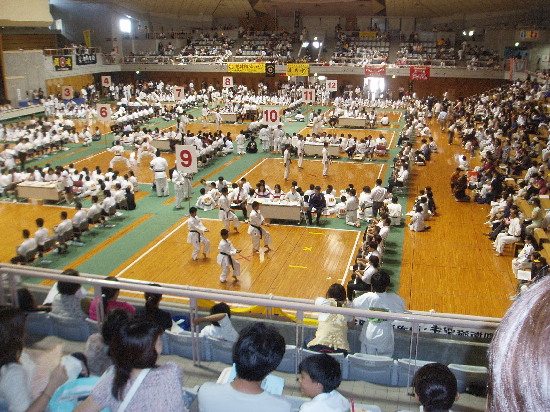 |
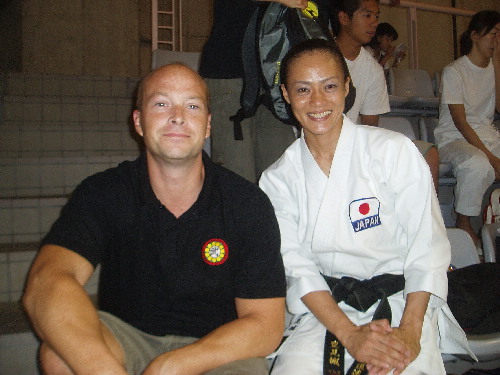 |
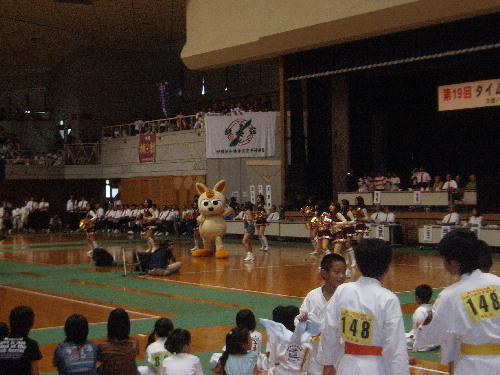 |
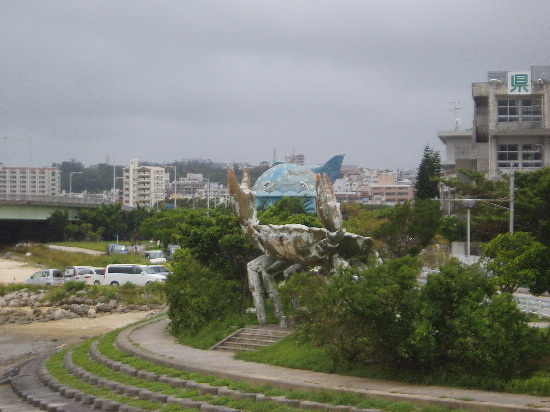 |
|
Izumi san and I left the Budokan for Kokusai dori to kill some time before we were to meet Tamaki Sensei and other Butokukan members at his favorite rock and roll oldies bar, Kentos. It is always a fun time there and we end up staying late . Tamaki Sensei loves rockabilly music and it is fun to watch him smile like a young boy
|
|
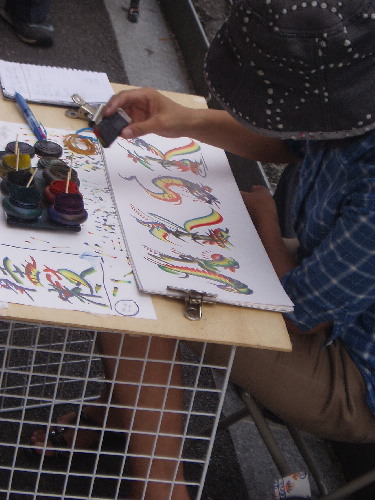 |
 |
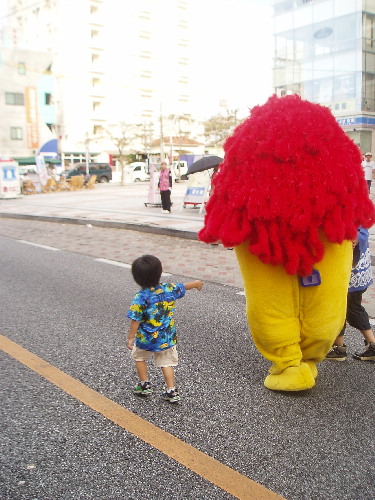 |
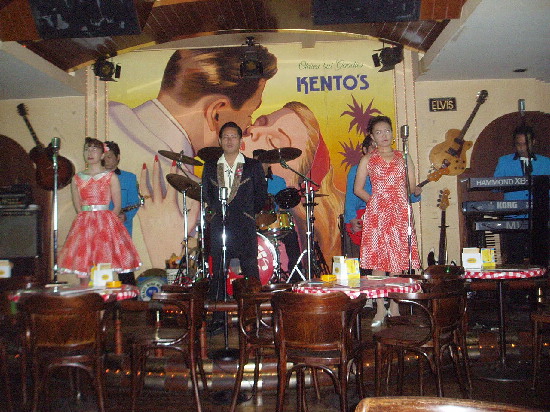 |
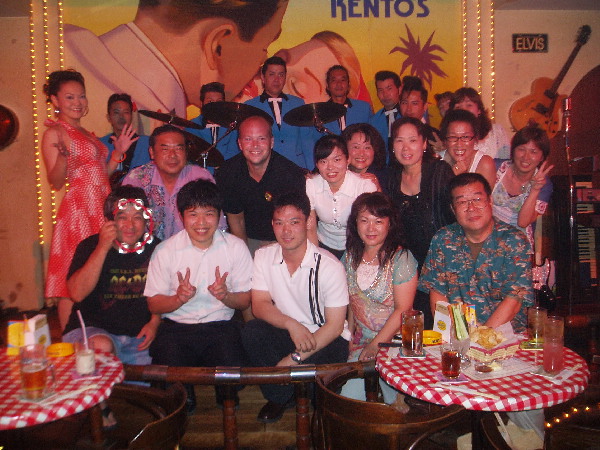 |
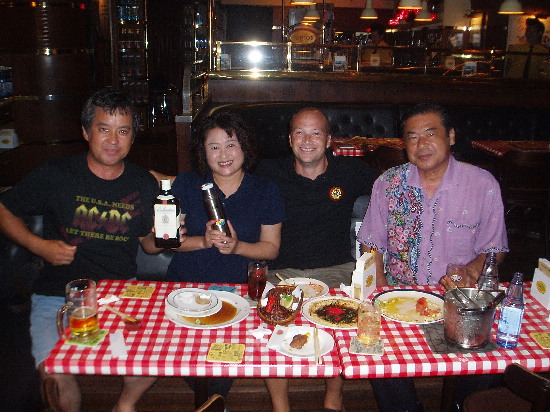 |
| Monday July 15
Tamaki Sensei and Sunagawa Sensei picked me up at 8:30 from Izumi Sensei's house and told me that we would be exploring the Northern half of the island. Last year they took us to Zakimi Castle and showed us the areas around Yomitan. Tamaki Sensei is walking encyclopedia about Okinawan history and it is always an honor to have him share this with me and others. He and Sunagawa Sensei always go out of their way to show me the culture and history of the island. History first-karate last.
We first drove to Bise point where Sunagawa's grandfather lived.Bise was very beautiful and the homes were surrounded by Fukugi trees, which serve as a wind buffer as well as a source of shade. The oldest of these trees is thought to be over 300 years old.
We explored the beach next to her grandfather's home for a while and she showed me a cave that she was warned not to go near as a little girl. On occasion, people have drowned in the water off the island and bodies had washed into the cove.
|
|
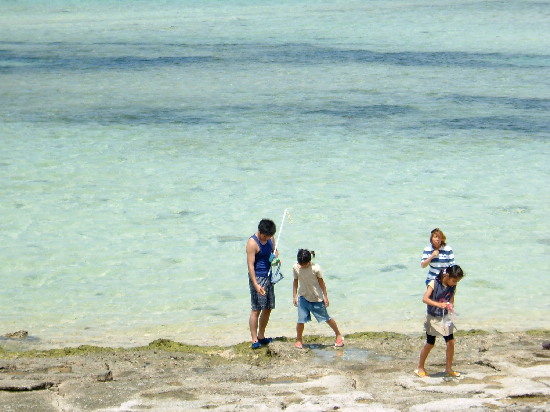 |
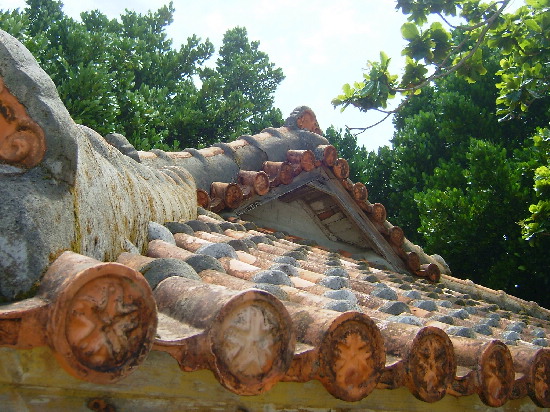 |
| Bise Point |
|
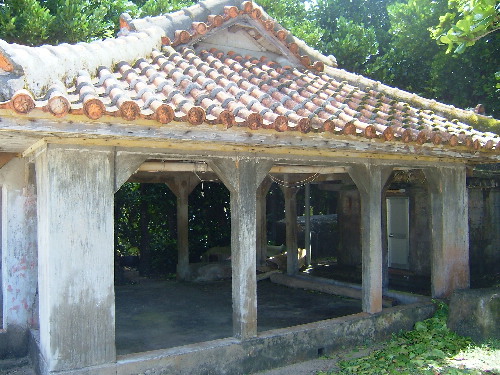 |
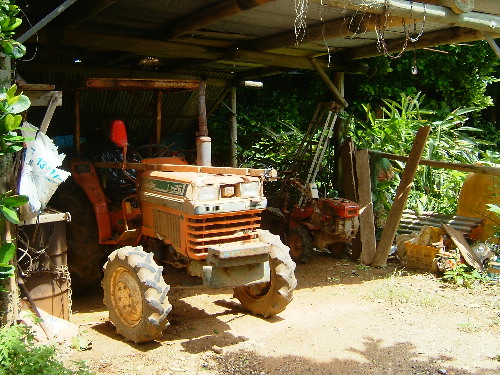 |
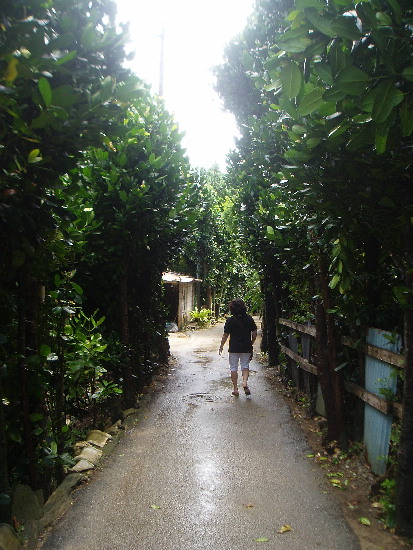 |
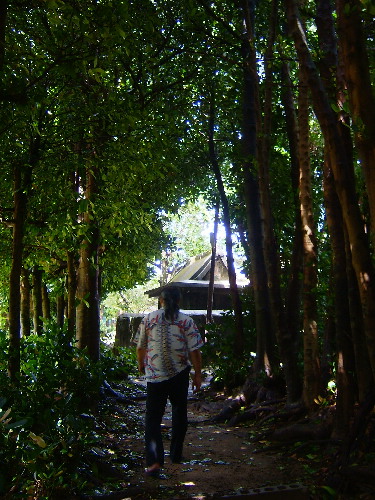 |
| The walkway to Sunagawa Sensei's family home in Bise |
|
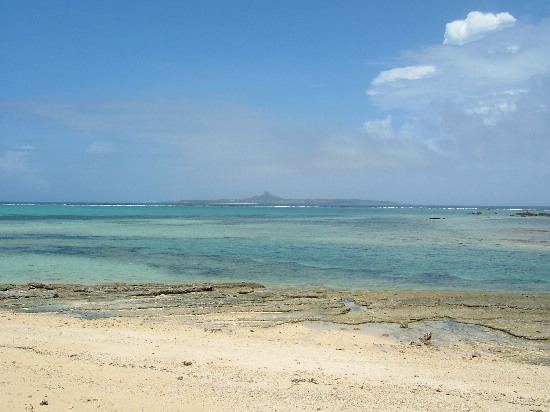 |
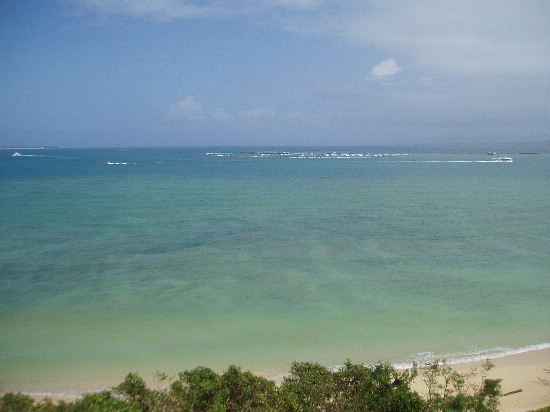 |
| Bise Point with Ie Island in the distance |
|
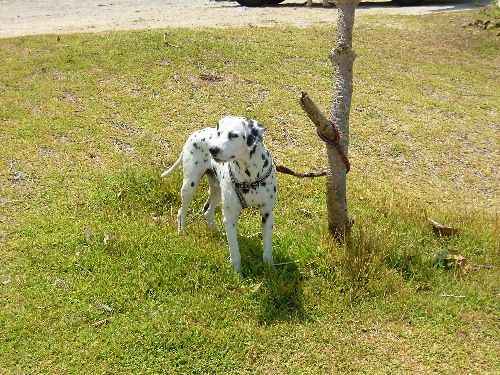 |
 |
|
|
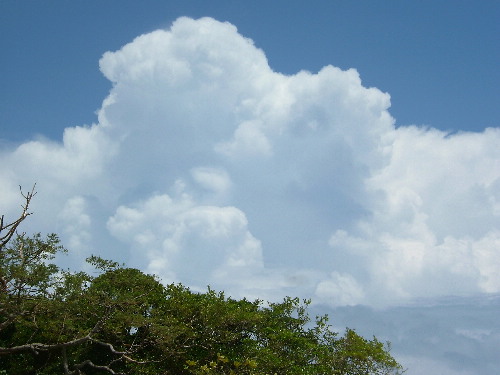 |
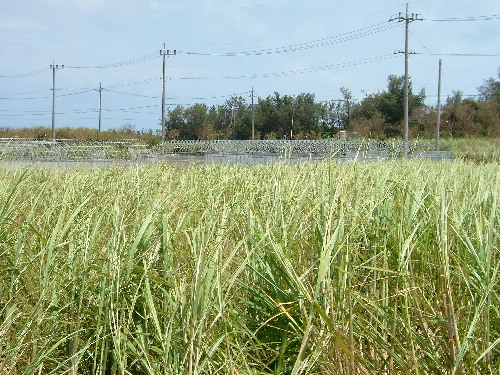 |
|
|
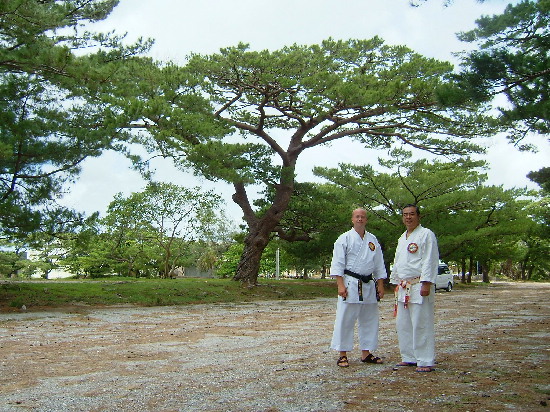
Nakahara no Baba
This historic place was where the Okinawans would hold horse races long ago. The stretch of land is surrounded by tall Ryuku Matsu (Okinawan Pine Tree) and an elementary school is now located next to the site.
|
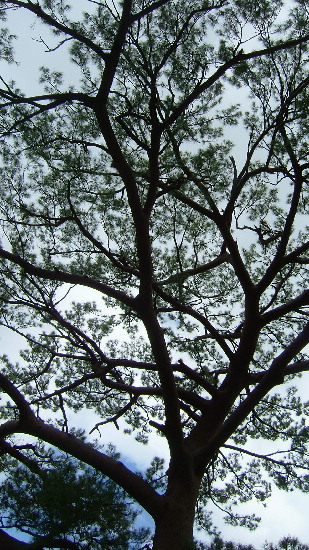 |
| Nakijin Castle
We then made our way to Nakijin Castle which is the second oldest gusku on Okinawa and was once the center of the Northern Kingdom.
|
|
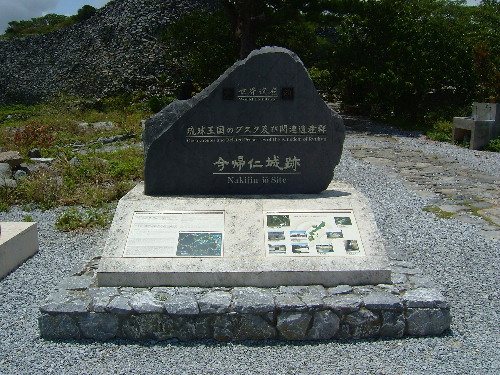 |
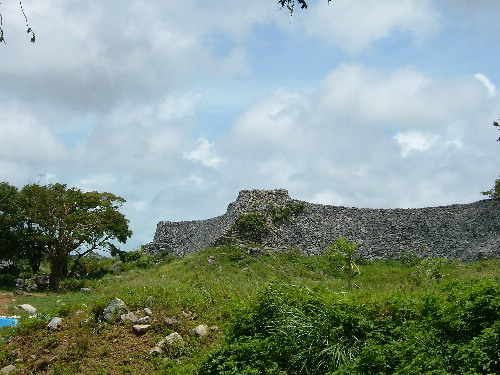 |
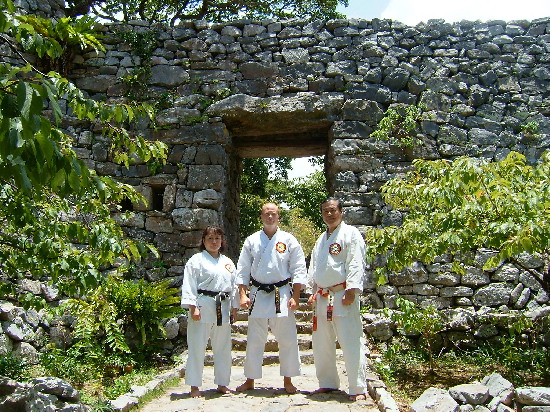 |
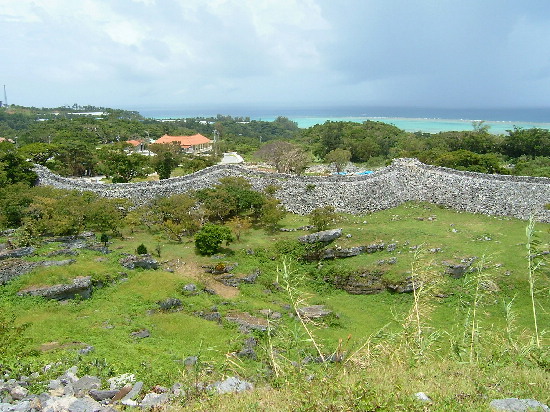 |
|
This is the southern training area of the castle where the bodyguards to the king practiced bo and spear techniques. |
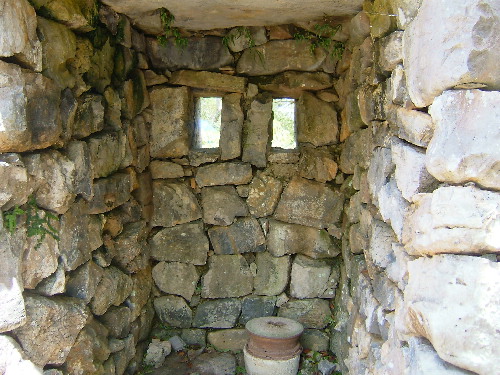 |
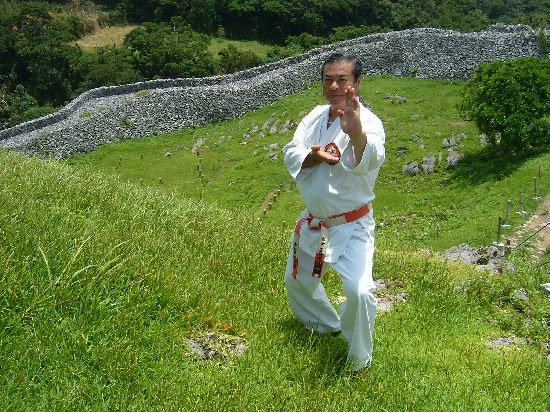 |
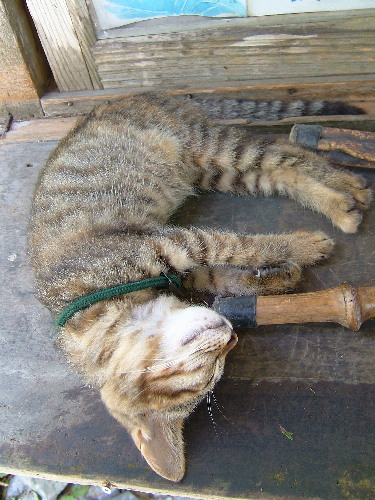 |
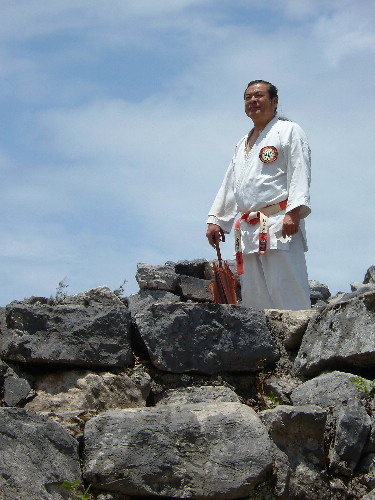 |
|
|
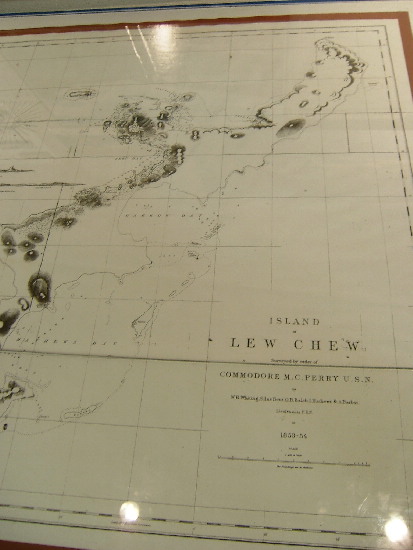 |
|
 |
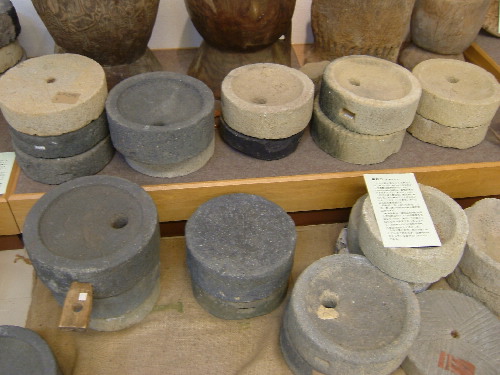 |
|
Grinding stones which were the origin of tunfa. |
| We arrived at Koori Jima(island) which is located near Nakijin Castle and has to be one of the most beautiful places that I have seen on Okinawa. It is now connected to the main island by a bridge whereas before you had to get to it by boat. It is famous for it's uni(sea urchin) and there are some places around it's wharf where you can buy it freshly shucked out of it's protective covering. We stopped by and watched the uminchu clean and prepare sea urchin and octopus and I purchased some for Izumi Sensei and his family. |
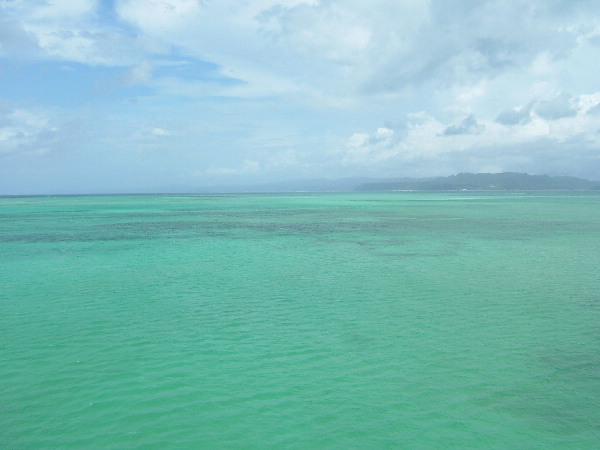 |
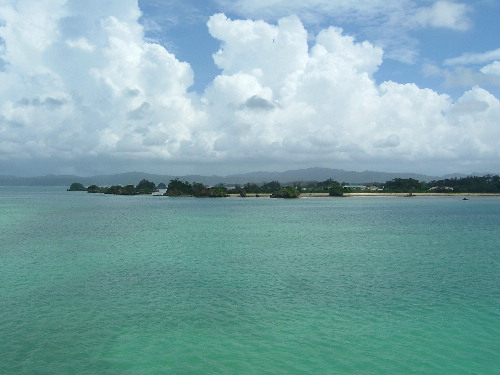 |
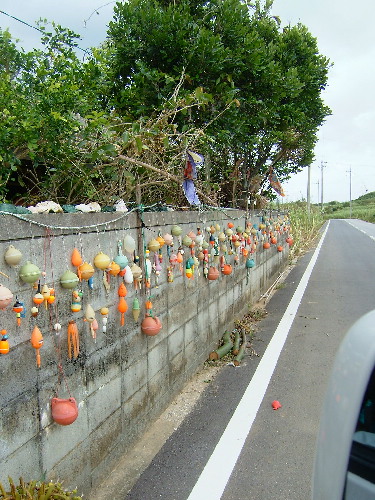 |
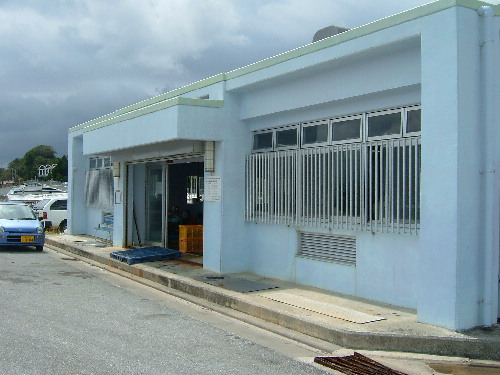 |
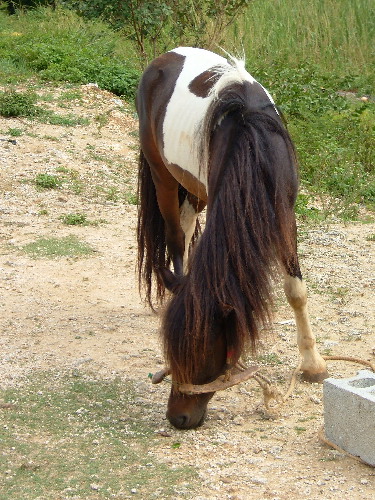 |
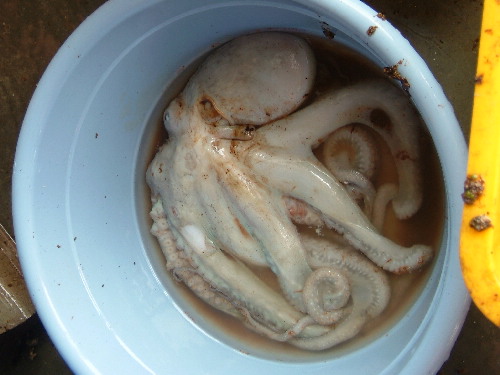 |
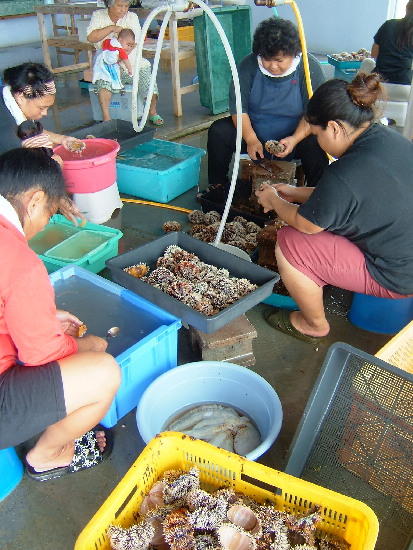 |
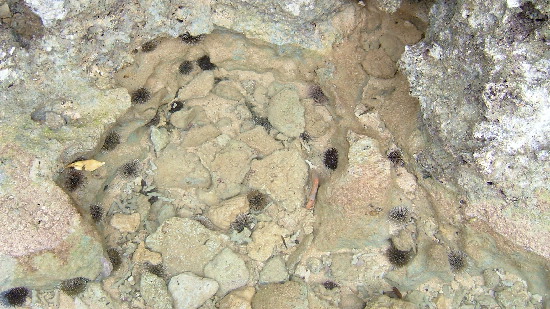 |
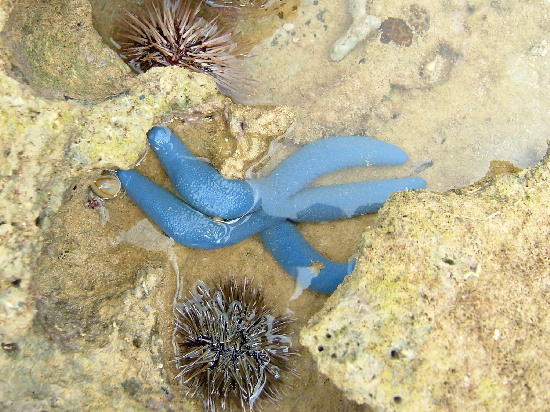 |
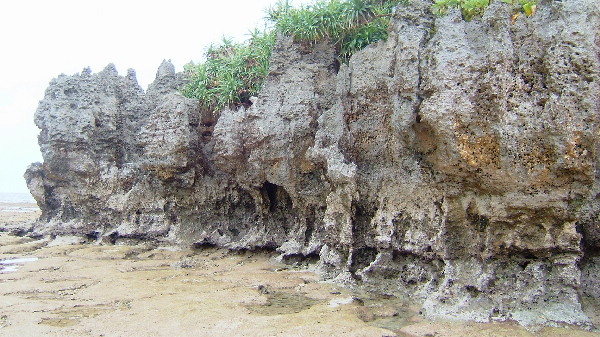 |
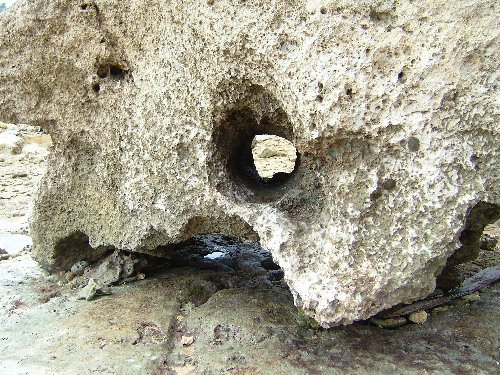 |
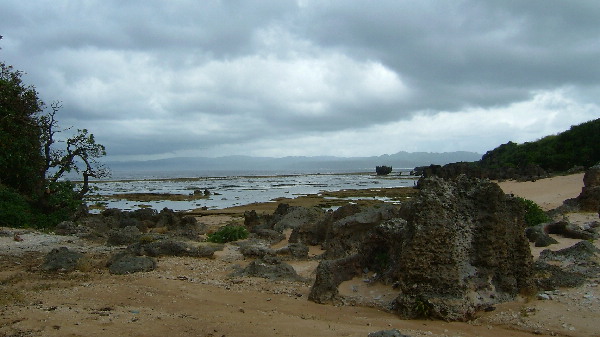 |
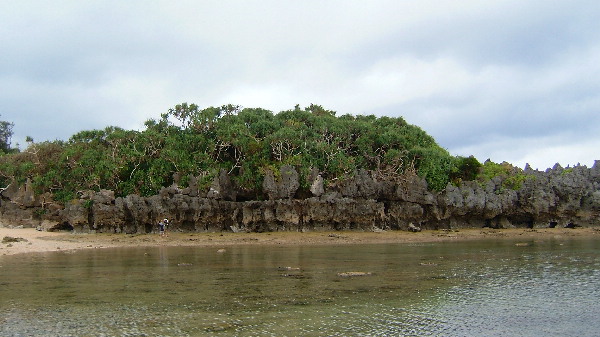 |
| Driving through Nago, Tamaki Sensei turned left into a road surrounded by sugar cane and I was amazed to see a wonderful soba restaurant tucked away behind these fields in a mango farm. I am so impressed of how much Tamaki Sensei knows of each town that we visit. This "oasis" was wonderful and the soba was a welcomed addition to our long day. We sat in a air conditioned tatami room and talked about how nice it would be just to crash there for the day and sleep! |
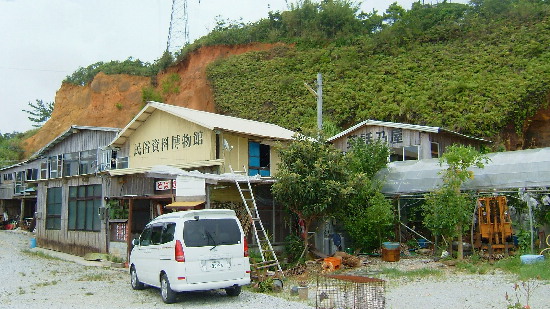 |
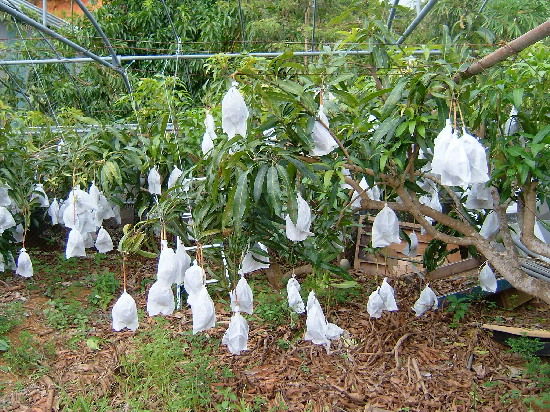 |
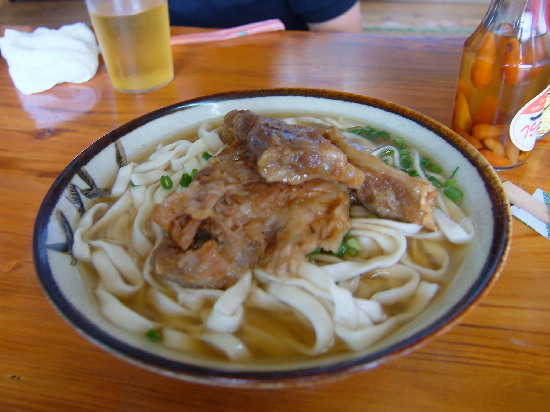 |
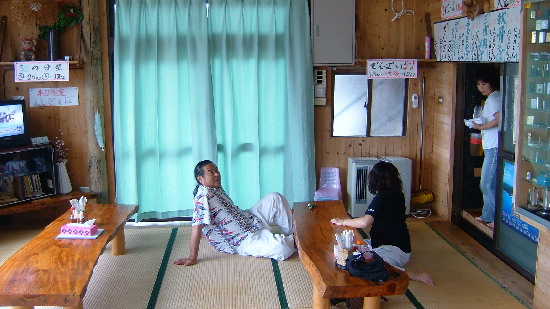 |
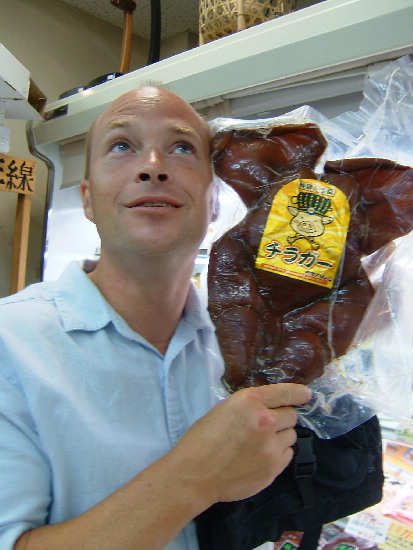 |
| Our final stop of the day was at Haneji Dam in Nago. This massive area is hidden in the mountains and is very impressive to see. |
The Okinawans used every part of the pig including the face which I am holding here. |
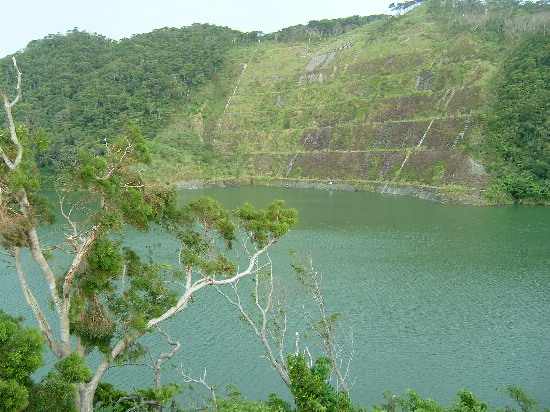 |
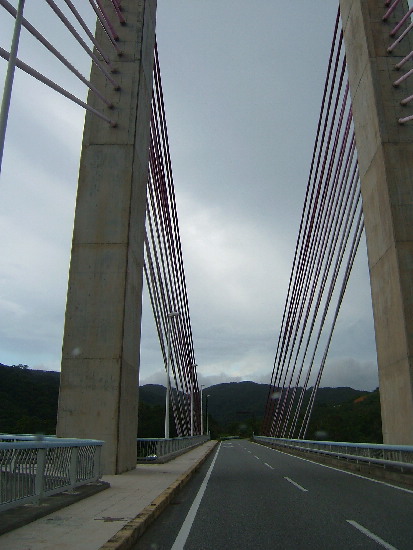 |
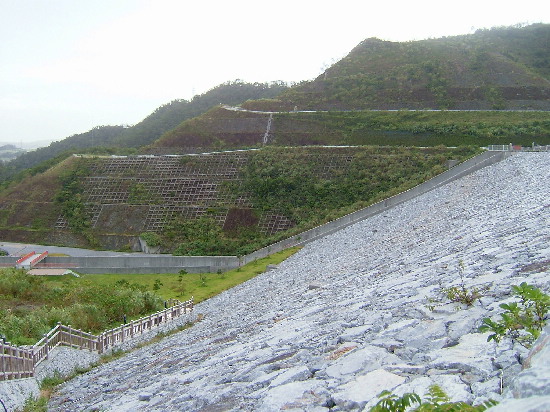 |
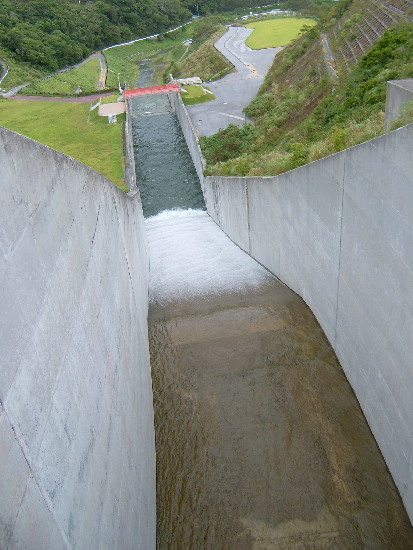 |
| We returned home and I said goodbye and thank you Tamaki san and Sunagawa san for the incredible day and the gifts they had gave me.
Izumi Sensei and I taught class at his dojo where we went over yakusoku kumite and kobudo. We were both extremely tired from the day before and were excited to get some food in our stomachs after class bowed out.
We had a wonderful dinner of the uni(sea urchin) that I bought for Izumi Sensei and his family. Hiroko san also prepared some fried octopus and spring rolls as well as some snails that one of Izumi Sensei's friends had brought by.
|
|
 |
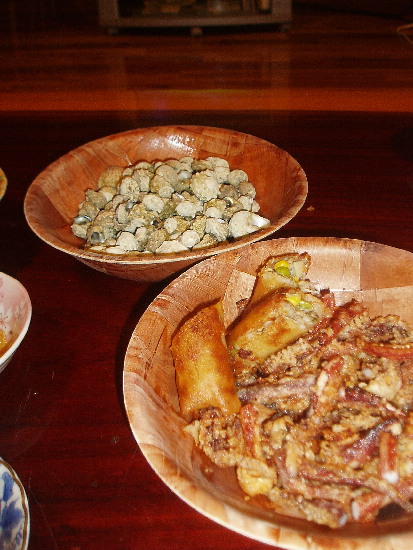 |
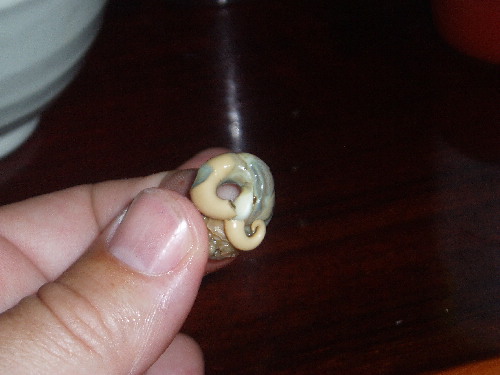 |
|

